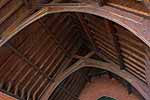 Brough Brough
St Stephen
Archaeology
The church comprises of a three-bay nave and single bay chancel under continuous roof, south porch, vestry, and a bell turret.
The body of the church dates from a single phase of building in 1885-6.
Technical Summary
Timbers and roofs
|
NAVE |
CHANCEL |
TOWER |
| Main |
 Principal rafter roof with two sets of moulded side purlins, scissor bracing above curved braces supporting rafters and bearing onto simply carved wall brackets; planed diagonal boarding above. All 1885-6. Principal rafter roof with two sets of moulded side purlins, scissor bracing above curved braces supporting rafters and bearing onto simply carved wall brackets; planed diagonal boarding above. All 1885-6. |
Principal rafter roof with plain collars and moulded side purlins. Short posts bear onto wall plates. All 1885-6. |
Bell turret has pitched roof, details not visible. 1885-6. |
| S.Aisle |
n/a |
n/a |
|
| N.Aisle |
n/a |
Vestry has pitched rafter roof with plain collars and posts bearing onto wall plates. All 1885-6. |
|
| Other principal |
South porch has pitched rafter roof with plain collars and posts bearing onto wall plates. All 1885-6. |
|
|
| Other timbers |
|
|
|
Bellframe
Single bell of 1885 in central wooden turret; frame apparently of timber, 1855-6, probably a simple gantry, but not yet accessed for recording.
Walls
|
NAVE |
CHANCEL |
TOWER |
| Plaster covering & date |
Open brickwork |
Open brickwork |
n/a |
| Potential for wall paintings |
None. |
None. |
n/a |
Excavations and potential for survival of below-ground archaeology
There have been no known archaeological excavations. However it is noted that Roman pottery was discovered during construction works in 1885-6.
The standing fabric of the church dates entirely from a single phase of building in 1885-6 on land that was formerly an agricultural field but is likely to have formed part of a Roman settlement alongside the Fosse Way. It is expected that below-ground stratigraphy will comprise a mixture of Roman deposits and construction evidence from 1885.
The standing fabric of the entire building has moderate importance as a mid-19th century church. It is listed grade II.
The churchyard is small and rectangular, with the church positioned towards the north. The former school rooms, now a private residence, lie beyond the boundary at the north end. There are no burials.
The overall potential for the survival of below-ground pre-1885 archaeology in the church and churchyard, is considered to be HIGH-VERY HIGH as evidenced by the discovery of Roman pottery during construction. The standing fabric of the church is of a single phase of 1885-6, it has potential for late-C19th archaeology in the standing fabric which is considered to be MODERATE.
Exterior:No burials. Evidence of Roman settlement and related deposits throughout.
Interior: Stratigraphy under the interior of the building is expected to comprise construction layers dating from 1885 with underlying and disturbed Roman deposits.
|